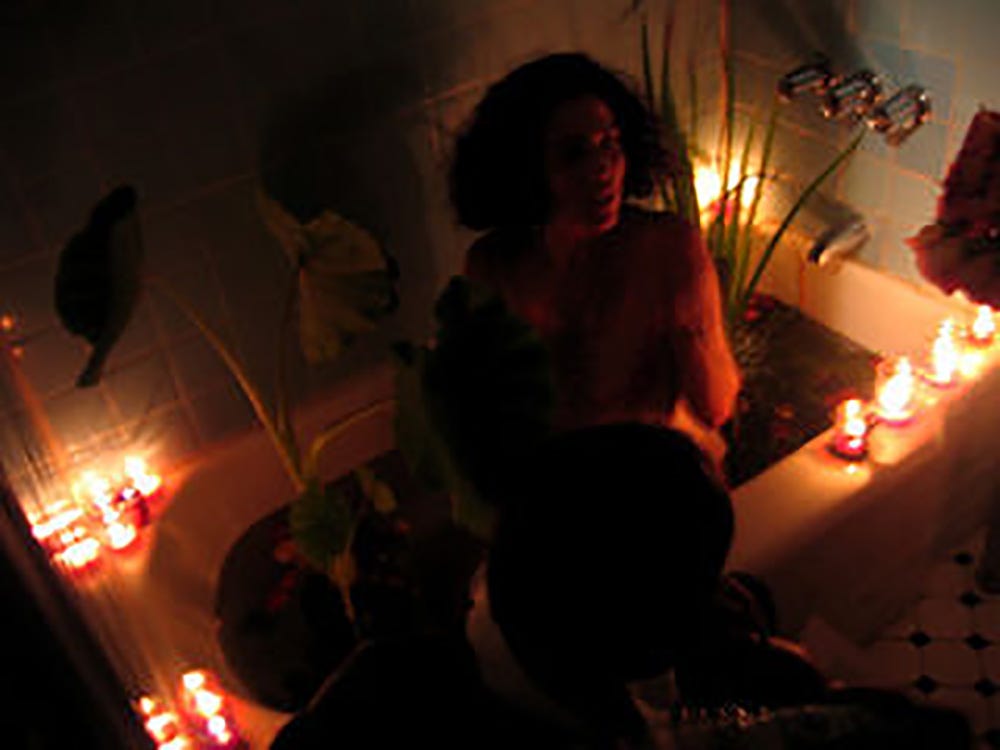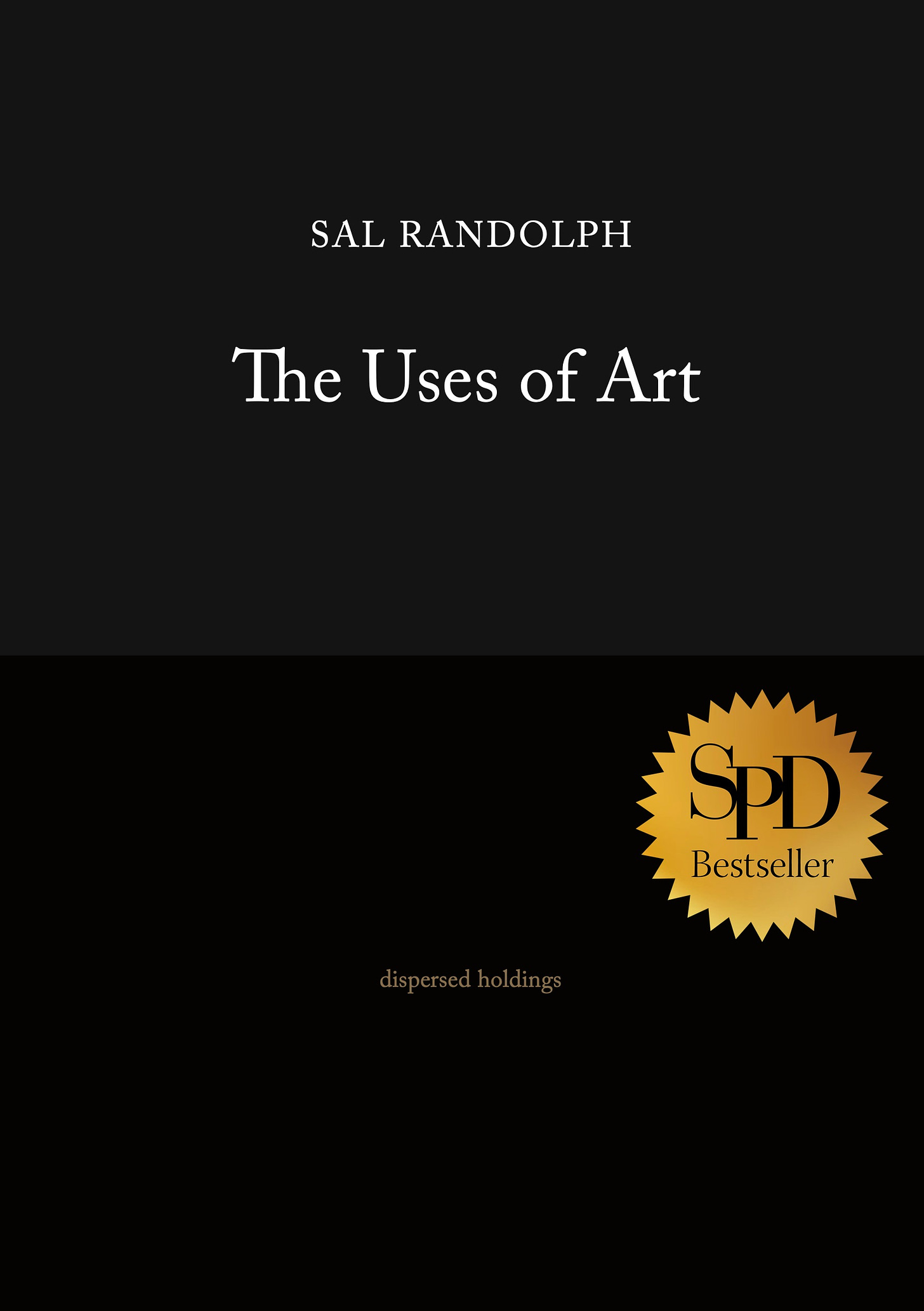Dear Friends,
In the middle of October I gave a reading in Provincetown — I knew my friend Kathe Izzo would be in the audience, so I read a section from The Uses of Art about her work as The Love Artist. It was a joy to read someone their own story.
Around the same time, Kathe started a newsletter here on Substack, My Braniac Amor, named for a lyric from Patti Smith’s song “Land.” Kathe describes My Brainiac Amor as “an unfiltered, all inclusive exploration of love, particularly love that is profound but fleeting, perhaps inappropriate or never realized ⚓.”
Since Kathe is in this Substack room, too, I’m going to repeat the pleasure of sharing her story. I am pairing it with another story that comes just before Kathe’s in The Uses of Art, about encountering a performance piece by the artist Tino Sehgal. It’s also a kind of love story.
Together, these experiences shifted my sense of what art could do — how intimately and directly it could sing to me.
— Sal
Good Vibrations
I walk out of a bright day, through a courtyard with an overhanging tree, a picnic bench, hammock, and a few smokers, and then through a door (someone motions me in) and a dark hallway, finally stepping into a room so black I’m blind. Dazzled by the darkness.
“Ch! Ch! Ch!” behind me and to my left: loud plosives. “Tk! Tk!” ahead and to my right. A beatbox of voices around me in the room. I can hear bodies, at first a sudden scuffle of feet and then a loud thumping shaking the floor. Frightening, the intense motion of all those bodies running and jumping in complete invisibility. I stand very still — I can see nothing of them, but hoping they can see and avoid colliding with each other and me. Trust. One comes up behind me, “Ch! Ch! Ch!” so close that her breath (by her height, a woman?) puffs against the back of my neck, sending waves of tickling sensation down my back and up into my scalp.
I was alone in the dark (quivering with attention), then found and sung to (almost too much), then, a bit later, dancing and making sounds with the troupe.
Five minutes later my eyes have adjusted enough to make my way gently across the room through the forest of dancers. Living shadows. I find a perch in the far corner and watch. They are telling a story now, or maybe it’s an essay, each trying out personal variations on the phrase, “The money I make doing insignificant things is not insignificant.” Sometimes an attempt, a variation is met with a group chorus of ‘no’ and the voice tries the sentence a different way. Then they are making rhythms again, and they start singing — the pale moon of one woman’s face turns to me, she is singing to me, and I recognize the opening words of “Good Vibrations.” It’s disconcerting and intimate. And then they are all dancing and singing the chorus, and when the next verse comes she’s a little closer, and singing again just to me.
All this, while new people are stumbling into the room, blind and stripped of their certainties. Now that I can see them, I feel a tenderness towards my earlier state, towards them in their own particularity, towards them-as-me.
There is much more you could say about this piece (Tino Sehgal’s This Variation — in Kassel, Germany, at the art show Documenta) but the part I’d most like to talk about is the least describable, resistant in almost every way to representation, even in language (our last resort when pictures fail?). The experience of the experience. The coming-into-sight from blindness and helplessness in this field of sound and action, voices and bodies. But also the coming-into-community from the solitary place of the (blind) observer.
I was alone in the dark (quivering with attention), then found and sung to (almost too much), then, a bit later, dancing and making sounds with the troupe. It seemed, if I stayed long enough, I’d become, in every way, part of the piece.
True Love
Being sung to in the Tino Sehgal darkness reminded me of being sung to by my friend Kathe Izzo during her Musical Theater of Love Seed Project. As part of an indie art fair at the Chelsea Hotel, Kathe made a water garden in the bathtub, singing love songs from it, half-submerged, while a guitarist-friend perched on the closed seat of the toilet to accompany her.
By that point, she had been working for several years as a ‘love artist.’ You could make an appointment with Kathe and she would fall in love with you for an hour or a day, sometimes in person, sometimes by phone or email, sometimes in a bed installed in a gallery. I had slept with her one night in such a fur-covered bed. And I’d had other love appointments with her, as she and I collaborated and crossed paths; we were poets together, back in the day, in Provincetown.
When she loves you, Kathe takes a picture of you and of herself and sets them side by side. In my picture I look shocked and frozen, far from the lens. Kathe looks close-up and tender. I have a corresponding picture of the two of us in a project of mine where I gave away money. We’re in summer tank tops at a round café table, holding an envelope full of money between us, grinning and looking into each others eyes.
Maybe because of this, I didn’t expect to be surprised when I dropped into the Chelsea—I thought I pretty much knew what she was up to.
Something Good
I step into the hotel room, which Kathe is sharing with her friend Giorgio, and find them flopped on the bed, relaxing and chatting. I’ve arrived between-times, and Kathe’s guitarist is out, but she tells me it will be better this way anyway, she’ll make a special time for me right now.
Asking me to wait a moment, she disappears into the bathroom. When I go in, she’s in the tub, wearing a sheer silk shift that holds to her body. There are flowers floating in the water, and the room is lit only by candles.
Maybe this is exactly what I want art to be, someone singing to me in the darkness, directly to me.
“My friend Matt usually sits there while he plays,” she says, gesturing to the closed lid of the toilet. It’s a tiny bath- room, just barely room for me to kneel on a cushion next to the tub. In the dim flickering light, the bathroom is both beautiful and funny, a water garden and a water closet.
“Let me hold your hand,” she says. “Let’s take a deep breath together.” I breathe in, I breathe out, looking into her eyes. “I’m going to love you today by singing you a song,” she says. “Can I put my hands on your head?”
“Of course,” I say.
“I’m going to do a little divination, and find the right song for you.”
She gets up on her knees, and suddenly we are very close, her body present in its wet silk sheath. I close my eyes. We stay like that a long moment.
“Ok, you can open your eyes, or keep them closed.”
We both sink down and look at each other, and then she starts to sing.
It’s “Something Good,” from The Sound of Music. Her voice wavers and wanders. It’s the directness and the flaws that move me. I know Kathe, but I didn’t know this. Maybe this is exactly what I want art to be, someone singing to me in the darkness, directly to me.
Kathe Izzo
Kathe Izzo’s My Braniac Amor
Today’s post is an excerpt from my book, The Uses of Art. Further adventures and new ways of seeing can be found there.
Artist Sal Randolph’s THE USES OF ART is a memoir of transformative encounters with works of art, inviting readers into new methods of looking that are both liberating and emboldening.
Dazzlingly original, ferociously intelligent.
— Michael Cunningham
A joyful, dazzling treasure-box of a book.
— Bonnie Friedman
Here’s a guide, to waking up, over and over again.
— Roshi Pat Enkyo O’Hara









